Leonard Sherwood, a founder member of the Society, wrote this for Harpenden Library in May 1974
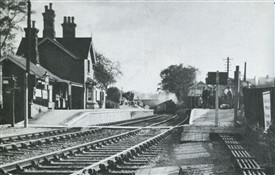
Harpenden East Station – opened in 1860. Credit: LHS archives
The 19th Century railway promoters were interested in their systems as a whole. Their objectives were to link large centres of populations, and to cheapen the cost of transporting the products of growing industries such as coal and cotton, previously fostered by the canals, by linking the points of production with the large towns and with the ports.
Like countless other places, Harpenden and Wheathampstead were mere incidentals in a railway system; they happened to be on a desired line of route.
There were stations at Boxmoor (1837) and at Hatfield (1850), but before 1837 some coal and manure was carted from the canal at Boxmoor, and these rather distant railheads were, when available, used for small amounts of the same traffics. Coal consumption was quite tiny, and hardly figured in the lives of farm workers whose families did straw plaiting.
A Victorian Enthusiasm for Railways
1845 was a critical year in railway development: George Hudson, the “Railway King” was interested in a large proportion of the 1428 separate schemes mooted in that year. The figure had been mounting up to this crescendo for several years; the crash, when it came in 1845, caused parliament to be much more critical of new schemes.
One early scheme was to link Luton with Chelmsford via Kimpton, Codicote, Welwyn, Hertford, Ware and Harlow. Another, in 1858, was to extend the newly opened Watford to St. Albans (Abbey) line to Shefford in Bedfordshire via Redbourn and Luton. The significance of Shefford will be seen later on. St. Albans (Abbey) was in fact Harpenden’s nearest railway in 1858.
The first railway proposed to enter Harpenden was a scheme proposed by a “Luton, Dunstable and Welwyn Railway”, promoted by Luton and Dunstable merchants to link their towns with the Great Northern Railway’s main line, which had been opened in 1850. Whilst the bill for this new line was opposed in both house of parliament, there is no evidence of Harpenden or Wheathampstead opposition.
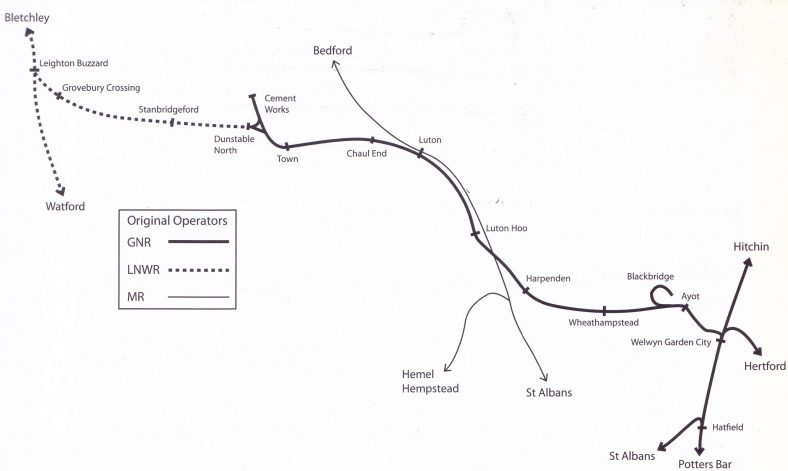
Route Diagram from Welwyn to Leighton Buzzard via Luton and Dunstable, opened 1860. Note the Bedford to London line was not yet planned or built. Credit: Branch Line to Dunstable from Leighton Buzzard to Hatfield, Woodward, 2008
The Arrival of the Railway
Another 1858 promotion was the Hertford and Welwyn Railway; this and the Luton venture joined forces to become the Hertford, Luton and Dunstable Railway. This concern opened in 1860, although it was worked by the Great Northern from the start, and was absorbed by that Company 12th June 1861. Stations were provided at Harpenden (near Batford) and at Wheathampstead.
George Bendale, born in Dursley, Glos., was the first Harpenden Station Master, being appointed at the age of 28. The 1861 census reveals that he had five children, born in Cheltenham and Barnet, which suggests that George was earlier employed on the railway at those places. This was surely the beginning of the moving into Harpenden of people from quite different parts of the country, which the railway did such a lot to accelerate.
Thus the first local line was not the present ‘Midland’ route, and it seems probable that if the Midland line had been built 10 years earlier than it was, the ‘Great Northern’ would never have come to the district at all.
The new line at once cheapened the cost of getting manure from London, and brought coal all the way by rail from Yorkshire, and it enabled work to be brought to the straw plaiters more easily from Luton.
The existing coach service between Luton and St. Albans succumbed at once, though a new once daily coach was started between the stations at Harpenden (G.N.R.) and St. Albans (Abbey).
The new rail route was only a single line to Welwyn, and the journey time to London was lengthy.
The Midland Railway
Unlike most of the familiar main railway routes radiating from London, the Midland was developed from the north towards London. The Midland Railway, incorporated in 1844, was based at Derby. For long it reached London only by using (and paying for the privilege) other companies’ lines. As early as 1839, its constituent, the Midland Counties Railway, reached Euston (Square) from Derby via Hampton in Arden. From 1840 to 1857 it got to Euston from the north via Leicester and Rugby; in 1857 the Midland had extended its own route southwards to Bedford and Hitchin, there to carry on over Great Northern tracks to Kings Cross.
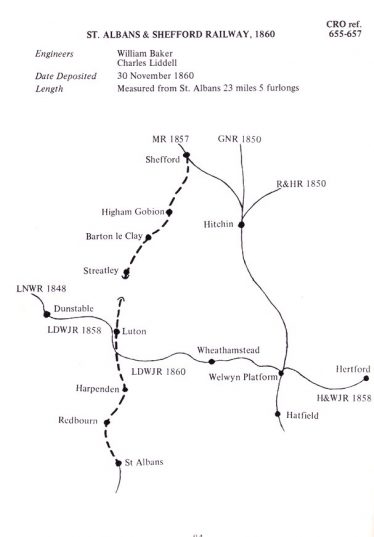
Proposed St. Albans & Shefford Railway Route, 1860. Credit: The Railways of Hertfordshire, Cockman, 1983
Shefford, mentioned earlier, lies between Bedford and Hitchin, so that there could have been a main route from London to the north via Watford, St.Albans, Redbourn, Luton, Shefford and Bedford. But the St. Albans – Shefford link never materialised. If it had, Harpenden today might well have been of the size that Redbourn is in fact.
In 1841 George Stephenson had been upset by opponents to railways in Luton, and declared that there shall be ‘no direct communication with London as long as I live’. This was said in pique; he died in 1848, but it was to be 20 years after this before Luton had direct communication with London.
Meanwhile, St. Albans and Luton people expressed jealousy of citizens of Watford and Hatfield, who had direct London lines in 1837 and 1850, respectively, and the M.P. for Bedford complained that his was ‘the worst served county in the country’.
The Midland Railway bought land south of the Regent’s Canal in London in 1861 in anticipation of extending its line from Bedford to London, and a bill for this extension was deposited with parliament on 29th November 1862. It received the Royal Assent late in 1863.
Opposing Views on the Railway
In favour of the bill there were of local interest Lord Verulam, John Bennett Lawes who complained of the limitations of the line already open (single track) and the distance involved in carting manure up the hill from the station near Batford; William Willis of Luton argued that the Great Northern line had caused the extinction of the coaches to London via St. Albans, with nothing to replace them, and said it was harder to take (straw plaiting) work out to the villages; James Allport, the Midland’s General Manager, said that the new railway would reduce the cost of coal by 4/- a ton about 25%. Bedfordshire and Hertfordshire farmers and Luton and St. Albans manufacturers were generally in favour.
Against the bill were not surprisingly, the Great Northern Railway Co., along with the Kings Cross coal merchants who saw a lot of their trade being diverted, and a number of owners, lessees and occupiers on the line of route, the last two in quantity, but with comparatively few owners’ names appearing.
Dissenting owners include Capel Adey, Richard Oakley, Jane Kingston, Elizabeth Whittington Healy and John Shaw Leigh; occupiers’ names appearing include Henry and Joseph Willmott, William Nott and John Saunders. One small shopkeeper at Bowling Alley protests pathetically of the railway robbing him of his business.
Early Railway Engineering
The construction of the line through Harpenden was part of Contract No. 5 of the Bedford-London route, and was let to Thos. Brassey and Stephen Ballard in the summer of 1865.
Henry Trethewy of Silsoe was appointed by the Company to ‘negotiate’ land purchase at the fixed rate of £30 per mile of line.
The new railway cut through the remaining vestiges of Westfield Common strips, and must have accelerated the enclosure process in that area.
Only at Bowling Alley was there much interference with houses, here were the biggest civil engineering works near Harpenden. Elsewhere construction was straightforward. There was some excavation in Stakers Lane- a cutting is apparent today, and a diversion of what is now Westfield Road.
Four lines of railway were provided for from the start, but only two were laid in at the outset, the others being added piecemeal along the route up to 1905.
A building was provided in 1865 for recreation and classes for railway construction workers; it is not clear at whose expense this was erected, though it is on record that elsewhere along the line the railway company agreed to contribute £50 towards a hut for workers as a place of worship. The Harpenden building later became an infants’ school. Miss Vaughan in ‘Thirty-three years at Harpenden’ records that a coffee room was put up at Bowling Alley in 1866, being open from 6 to 9am and 6 to 10pm, with tea, coffee and cocoa at ½d, per cup.
It was not long before there were complaints of rowdiness on Saturday nights among construction workers. Later on the Railway Company stopped the issue of cheap tickets on the annual occasion of Harpenden Races, because of the complaints that undesirable elements were being brought to the village.
A report to the railway management on the progress of construction bemoans the fact that in 1866 the labour force was denuded by demands of local farmers for labour to gather the harvest. Railway Company’s minutes include the following:-
135. 21st June 1865. ‘That the Secretary communicates with Mr Liddell (the Midland Railway Engineer) and ascertain if any agreement, verbal or otherwise or understanding, has been made with Mr. Packe, that Harpenden Station should be on any particular site’.
607. 1st Oct 1867. ‘Letter from G.W. Lydekker urging a footbridge 200 yards north of the station. To be referred to Mr. Liddell for estimate of cost’.
1142. 16th March 1869. ‘Acceptance of tender for new Station Master’s house’. (£425) (the house was identical with others along the line).
Impact of The Midland Railway
Harpenden station was opened for goods and coal in December 1867. Passenger services to Moorgate started 13th July, and to the newly opened St. Pancras 1st October 1868. There were 6 trains each way per day. Trains consisted of 4-wheeled coaches with 3 classes of passenger; the Midland Company abolished all 2nd class accommodation in 1875, being the first British railway to do so.
Immediate effects of the new mode of transport were to provide the area with regular London newspapers, to give much greater postal regularity, and to give a new sort of employment.
In 1874 it is recorded that H. O. Oggelsby was appointed as Supervisory Clerk at Harpenden Station at the age of 14, his salary being £15 per year. Adult porters were employed at 17/- per week, probably, a 12 hour day.
In 1870, on the occasion of the wedding of Sir John Lawes’ daughter, Sir John treated members of the Rothamsted Allotment Club to a rail excursion to the Crystal Palace, which, is recorded, was highly appreciated.
The development of passenger traffic was slow for the first 15 years or so following the opening of the line in 1868. Most travel was local, to secure higher wages in Luton and St. Albans.
Gradually professional and business people with work in London moved into newly built houses in Milton and Carlton Roads in particular, and later into the ‘Avenues’. Passenger journeys from Harpenden numbered 27,000 in 1872; 30 years later it was 9 times this figure, during which period the population just about doubled, as did the tonnage of coal arriving by rail.
It was not until well into the 20th century that the ‘white-collared’ worker came to use Harpenden as a dormitory.
Mr Henry T. Hodgson, who was a director and vice-president of the Midland Railway Co. for no less than 45 years, lived at ‘Welcombe’ for much of this time. He died in 1918.
The Nickey Line
Any account of railway development in the area cannot omit the so- called ‘Nickey Line’. In 1865 powers were sought to connect the town of Hemel Hempstead with the main London and Western line at Boxmoor. This short line was never built, but shortly after, under the title of the “Hemel Hempstead and L. N. W. Bill”, plans were deposited to build a line from the intended end of this line in Hemel Hempstead to Redbourn and Harpenden; this line was planned to cross the common near Hatching Green, make a junction facing North with the as yet incomplete Midland Line at Bowling Alley, to carry on by tunnel under the ridge where the water tower now stands, and join the Great Northern Line with a junction again facing North.
Opponents to the whole scheme are recorded as Fred Vandermeulen, John Bennet Lawes, John Shaw Leigh, and John Isaac House. The plans were altered, the route was aligned to take a course North of Harpenden, to join the Midland at Westfield with a junction facing Luton, and the Great Northern near Coldharbour, with a junction facing South (i.e. towards Harpenden East Station). The line from Hemel Hempstead to the Midland junction was completed and trains ran between Hemel Hempstead and Luton for the first time on 16th June 1877. In 1888 the curve at Westfield was altered to run southwards to Harpenden Station, and the train service became one between Hemel Hempstead and Harpenden, where there was a bay platform to accommodate the trains. The opening of ‘halts’ on the ‘Nickey Line’ did not take place until about 1905, the one at Roundwood, of which there is still ample evidence, being later than this. The line was incorporated into the Midland system even before it opened.
It is not easy to appreciate the motive behind the building of this line; admittedly a railway was in the 19th century better than whatever preceded it as a means of transport. Passenger wise, it forever struggled, and the very considerable developments of freight traffic in much later years could hardly have been foreseen.
The line was the subject of an experimental ‘Ro-Railer’ (so-called) in 1931. This vehicle could run on rails or transfer to the road at selected points to operate as a bus. The object was to counter growing bus competition. However the formation of the London Passenger Transport Board in 1933 put an end to this enterprise.
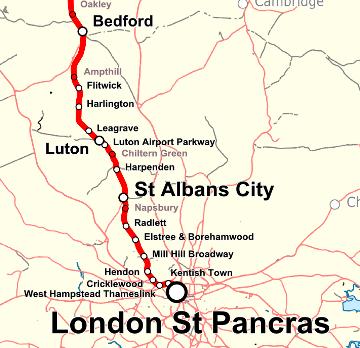
Midland Main Line. Credit: Wikipedia
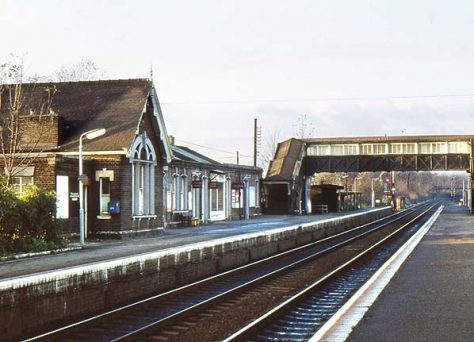
Harpenden Railway Station 1970s. Credit: LHS archives
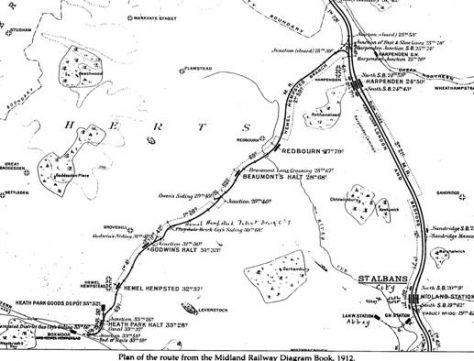
Plan of the Nickey Line Route, 1912. Credit: The Harpenden to Hemel Hempstead Railway. The Nickey Line, Woodward, 1996
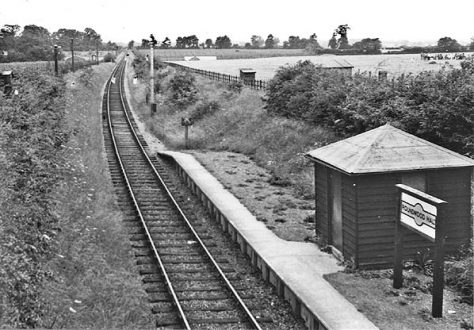
Roundwood Halt. Credit: LHS archives

No Comments
Add a comment about this page